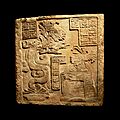Lintel facts for kids
A lintel is a strong, flat piece of material. It goes across the top of openings in buildings. Think of doors, windows, or fireplaces. A lintel helps to hold up the wall above the opening. It can be a simple support or a beautiful decoration. Sometimes it's both!
The bottom part of a window is called a sill. A sill doesn't hold up the wall. A lintel, however, is designed to bear weight.
Today, lintels are often made from prestressed concrete. These modern lintels are also called beams. They are used in floors and roofs to create strong, flat surfaces. An arch works in a similar way to a curved lintel.
Contents
What Lintels Do: Holding Up Weight
Lintels have been used for thousands of years. They are a key part of "post and lintel" construction. This is where a horizontal beam (the lintel) rests on two vertical supports (posts). Many different materials have been used for lintels, like wood, stone, or metal.
In ancient Western architecture, a lintel was a main part of an entrance. It was called an architrave. This strong piece would rest on stone pillars or columns. It would be placed above a doorway.
One amazing example is the Treasury of Atreus in Mycenae, Greece. This ancient building was made around 1600-1100 BCE. Its lintel weighs about 120 tons! It is one of the biggest lintels in the world.
Lintels can also support a chimney above a fireplace. Or they can span a path or road. This forms a stone bridge.
What Lintels Do: Decoration and Art
Lintels are not just for holding up weight. They have also been used as beautiful decorations. Many cultures have used lintels to add art to their buildings. These decorative lintels often have no structural job.
In ancient Egypt, lintels were carved with designs. You can see them in large halls and on stone slabs called stelas. In India, ancient Buddhist temples were carved into caves. These rock-cut temples had carved stone lintels. They looked like wood but were made of durable stone. Artisans could even make them look like wood grain!
The Hoysala architecture in southern India is famous for its art. Between the 11th and 14th centuries, many temples were built. They had very detailed stone lintels. These were often just for decoration. The Chennakesava Temple is a great example.
The Maya civilization in Mexico also created amazing art. They carved beautiful lintels for their buildings. The city of Yaxchilan has many examples. The earliest carved lintels there are from 723 CE. Fifty-eight lintels with detailed carvings span the doorways of major buildings. Some show queens celebrating kings.
Types of Lintels
Lintels can be grouped by their main purpose.
Decorative Lintels
- Atalburu – A special decorative lintel from the Basque region.
- Marriage stone – A lintel that is often decorative, but can also be structural. It usually has names or dates carved into it.
Structural Lintels
- Architrave – A structural lintel or beam that rests on columns.
- Dolmen – Prehistoric tombs made of large stones. They often have structural stone lintels.
- Dougong – A traditional Chinese structural element. It uses interlocking wooden brackets.
- I-beam – Strong steel beams. These are often used as lintels in modern buildings.
- Post and lintel – A basic building method. It uses vertical posts to support a horizontal lintel.
Images for kids
-
Structural lintel over entrance, Treasury of Atreus, Mycenae, Greece
-
The lintel stone at the Treasury of Atreus (external view)
-
The lintel stone at the Treasury of Atreus (internal view)
-
Shebna Inscription on a lintel of a tomb cave near Jerusalem, 8th/7th century BCE
-
Structural lintel with a lauburu and founders' names, above traditional Basque houses in Lower Navarre, Spain
-
Non-structural Mayan ornamental lintel stone, from the Yaxchilan city site in Chiapas, southern Mexico. (Late Classic period, 600-900 CE).
-
Non-structural lintel in Buddhist cave temple at Ellora Caves, India
-
Door lintel in Bozen-Bolzano from 1632 with Elias Tagger's coat of arms, South Tyrol, Italy
-
Non-structural marriage stone lintel at 'The Hill' farm, Dunlop, East Ayrshire, Scotland
-
One of many 16th century door lintels in Edinburgh's Old Town
See also
 In Spanish: Dintel para niños
In Spanish: Dintel para niños
- Span (architecture)














